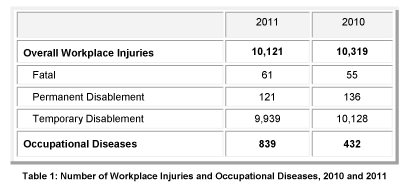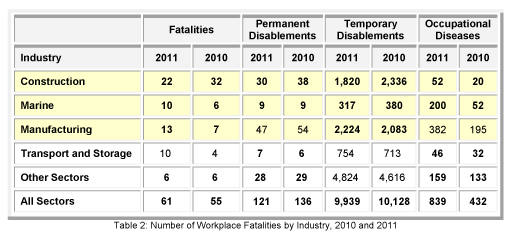61 Workplace Fatalities in 2011
Nearly half contributed by slips, trips and falls from heights
14 March 2012
- In the latest Workplace Safety and Health (WSH) Statistics Report 2011 issued by the WSH Council and the Ministry of Manpower (MOM), workplace fatalities went up from 55 in 2010 to 61 in 2011, of which 26 (or 43%) involved slips, trips and falls from heights. Workplaces lost more productive hours, with a 6% increase in man-days1 lost due to work incidents. Another notable statistic was the increase in reported Occupational Diseases (OD). This rise was primarily due to efforts to address potential under-reporting of workplace health concerns in Singapore’s workplaces2.
- Overall work injuries in 2011 fell by 1.9%, supported by a drop in both temporary and permanent disablement cases which fell 11%. The workplace fatality rate stood at 2.3 per 100,000 employed persons, as compared to 2.2 in 2010.

Sector-specific overview
- The three traditional sectors (Construction, Marine and Manufacturing) accounted for more than 70% of workplace fatalities, permanent disablements and occupational diseases.
- Overall, the Marine and Manufacturing sectors showed an increase in numbers reported. The Manufacturing sector (especially the metalworking sub-sector) continued to account for most permanent disablements (about 40%) and occupational diseases (about 46%). In contrast, the Construction sector, while still the top contributor of workplace fatalities, registered a decrease in fatal numbers for the first time in the past 3 years.
- While traditional sectors account for most of the more serious injuries, in terms of temporary disablements3, the transport and storage, hotels and restaurants, wholesale and retail sectors accounted for more than 50% of the cases.

- Commenting on the report, Mr Heng Chiang Gnee, Acting Chairman of the WSH Council said, “The downward trend in injuries reported in the traditional sectors suggests that our efforts in these sectors may have helped to improve overall standards. However, their fatality numbers remain high. We are deeply concerned that the Small and Medium-size companies (SMEs) in these sectors, which account for most of the cases, continue to see recurrence of incidents that could have been prevented if risk management measures were well implemented. The Council will be stepping up efforts, such as through the WSH Assist programme, to focus on getting SMEs to improve their WSH management in a more structured manner, especially in areas of concern like work at heights.”
Almost one-third of fatalities due to falls from heights
- There was a notable increase in slips, trips and falls from heights incidents from 22 in 2010 to 26 in 2011. Of the 26 cases, 17 cases involve falls from heights, which accounted for 28% of the total fatalities last year.
- To address falls from heights issues, the Council-led Work at Heights Taskforce has engaged construction sites and shipyards over the past two years4. While the construction and marine sectors saw a drop in falls from heights fatalities from 14 cases in 2010 to 9 in 2011, MOM’s inspections reveal lingering concerns in these areas. In addition, the number of such incidents from the Manufacturing and others sectors rose from 3 cases in 2010 to 8 in 2011. Falls from heights risks were seen in works on roofs, ladders, as well as open sides in buildings under construction and lack of barricades in structures.
- Highlighting MOM’s plan to focus on falls from heights is WSH Commissioner Mr Ho Siong Hin, “MOM will need stronger measures than before to tackle falls from heights across all sectors. Hence, we had announced possible new legal requirements on working at heights in Parliament last week5. This may include mandating fall prevention plans that the Council has been promoting to specific sectors over the past two years, as well as a “Permit to Work system” for hazardous works such as working on roofs. Consultation on the possible new regulations will take place in the first half of this year. In the meantime, we will intensify our enforcement efforts nation-wide including more inspections, to ensure workplaces put in place proper measures to protect workers from fatal falls.”
- Industry stakeholders who want to find out about the Report can visit the WSH Council website.
1 In 2010, 532,769 man-days were lost due to workplace incidents. This increased to 565,275 man-days lost in 2011.
2 The International Advisory Panel on WSH had suggested for more efforts to encourage reporting of ODs. Hence, more in-depth and thorough surveillance efforts have been rolled out by the Ministry of Manpower in the traditional sectors to unearth possible cases. In addition, the newly-formed WSH Council Workplace Health Committee has also begun engaging medical practitioners to encourage reporting of ODs. These have seen greater awareness and reporting by stakeholders. More accurate reporting will aid better analysis of workplace health issues so as to address such concerns holistically. More importantly, some diseases detected and reported earlier can benefit from early intervention so that affected workers can better manage their conditions for recovery and rehabilitation.
3 A temporary disablement is an injury, other than fatal and permanent disablement, which results in more than 3 days of medical leave or at least 24 hours of hospitalisation.
4 More than 12,000 workers were engaged in over 1,800 worksites and shipyards. More than 5,500 supervisors were trained.
5 Please read the speech delivered by MOM Senior Parliamentary Secretary Mr Hawazi Daipi here.
Workplace Safety and Health Report 2011